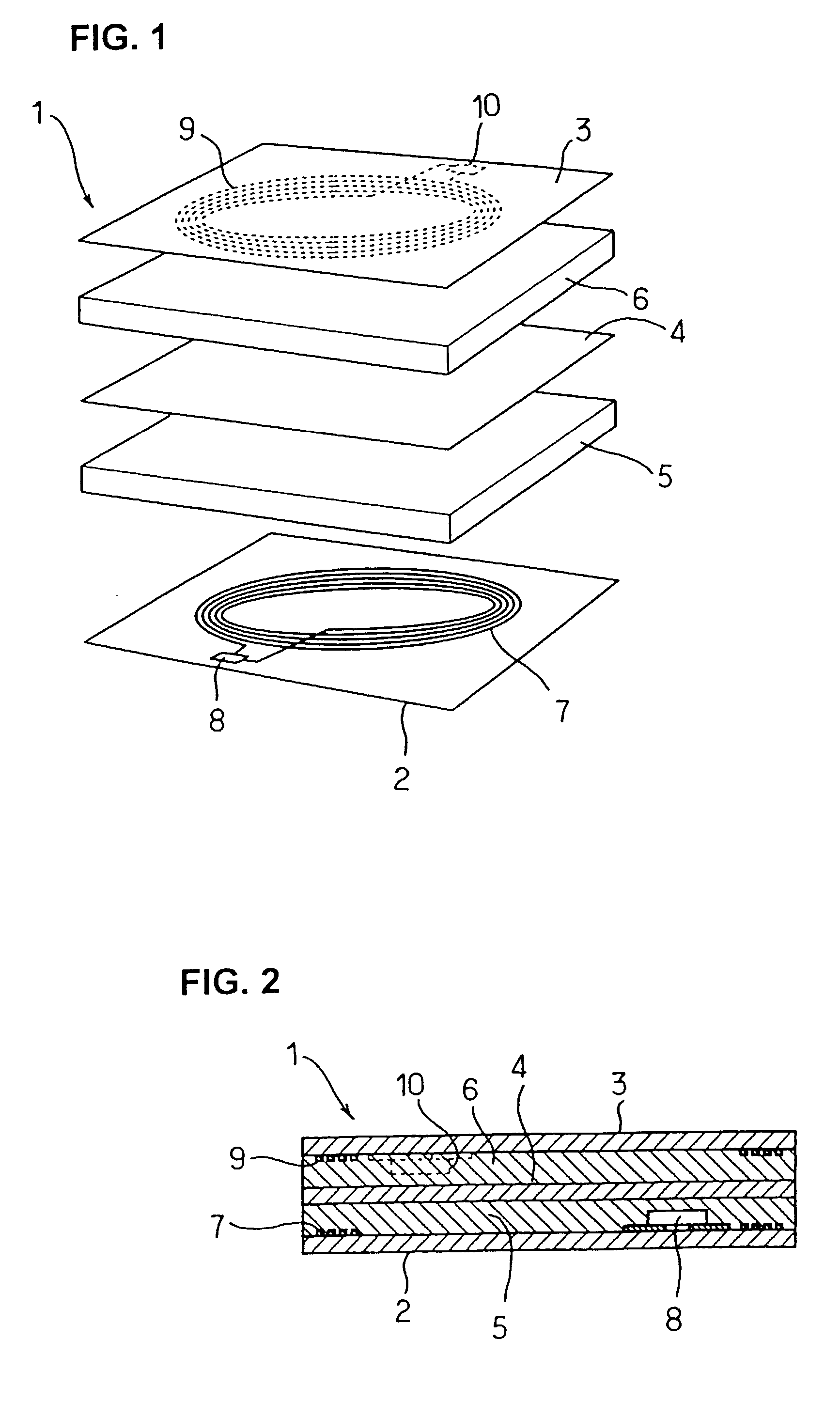Non-contact IC card having enhanced reliability
a non-contact, ic card technology, applied in the direction of instruments, printing, semiconductor/solid-state device details, etc., can solve the problems of excessive failure rate of non-contact ic cards, damage to ic chips, and inability to operate, etc., to achieve the effect of enhancing reliability
- Summary
- Abstract
- Description
- Claims
- Application Information
AI Technical Summary
Benefits of technology
Problems solved by technology
Method used
Image
Examples
second embodiment
[0047]FIGS. 4A to 4F are diagrams for illustrating a manufacturing process for a second embodiment of a non-contact IC card. Components of this embodiment which are identical to those of the first embodiment are indicated by correspondingly identical reference numerals.
[0048]With the second embodiment both of the combinations of the antenna coil 7, IC chip 8 and the antenna coil 9, IC chip 10, are mounted in common on the same one of the two plastic sheets 2, 3 which constitute the covering of the non-contact IC card. In this case it is assumed that both combinations are mounted on sheet 2.
[0049]The manufacturing process is as follows. Firstly, as shown in FIG. 4A, one of the antenna coils (antenna coil 7) is formed on the upper face of the sheet 2 by a screen printing process using an electrically conductive paste. Next, as shown in FIG. 4B, an electrically insulating layer 11 is formed over the antenna coil 7 on the upper face of the sheet 2, by a printing process using an electri...
third embodiment
[0053]FIG. 5 is a plan view illustrating a third embodiment of a non-contact IC card (as seen with the sheet 3 removed). Components of this embodiment which are identical to those of the second embodiment are indicated by correspondingly identical reference numerals. With this embodiment, as shown in FIG. 5, both the antenna coils 7 and 9 and the IC chips 8, 10 are formed on the same one of the two sheets 2, 3 which form the cover of the card (in this example, on sheet 2). However the antenna coil 9 and IC chip 10 are disposed within the inner periphery of the antenna coil 7, with the IC chip 8 disposed at the outer periphery of the antenna coil 7.
[0054]With the third embodiment, since the configuration of the non-contact IC card is similar to that of the second embodiment, similar advantages are obtained to those described hereinabove for the second embodiment.
fourth embodiment
[0055]FIG. 6 is a plan view illustrating a fourth embodiment of a non-contact IC card (as seen with the sheet 3 removed). Components of this embodiment which are identical to those of the third embodiment are indicated by correspondingly identical reference numerals. With this embodiment, as shown in FIG. 6, the antenna coil 7 and IC chip 8 are mounted in a region which occupies approximately half of the upper face of one of the two sheets 2, 3 (in this example, sheet 2) while the antenna coil 7 and IC chip 8 are mounted in a region which occupies the remaining half of that upper face of sheet 2.
[0056]With the fourth embodiment, it becomes possible to configure the IC card read / write apparatus with an antenna coil arrangement which matches that of the antenna coils 7, 9 of a non-contact IC card 1. In that case, it would be possible for the IC card read / write apparatus to concurrently perform mutually independent transmitting / receiving of data for both the IC chips 8, 10 of a card 1....
PUM
 Login to View More
Login to View More Abstract
Description
Claims
Application Information
 Login to View More
Login to View More - R&D
- Intellectual Property
- Life Sciences
- Materials
- Tech Scout
- Unparalleled Data Quality
- Higher Quality Content
- 60% Fewer Hallucinations
Browse by: Latest US Patents, China's latest patents, Technical Efficacy Thesaurus, Application Domain, Technology Topic, Popular Technical Reports.
© 2025 PatSnap. All rights reserved.Legal|Privacy policy|Modern Slavery Act Transparency Statement|Sitemap|About US| Contact US: help@patsnap.com



